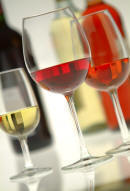 |
This section
deals with cooking all manner of foods with the addition of various types of
alcohol: wines, fortified wines, spirits, beers, cider and liqueurs.Â
Â
Adding alcohol to recipes, even everyday ones, adds another dimension to the
taste and can even transform an ordinary recipe into something spectacular and
worthy of dinner parties or special occasions. Its addition adds a richness and
flavour which can�t easily be achieved by any other method and in some cases the
alcohol doubles as a meat tenderiser.
One question which is often asked is whether the alcohol content remains in the
finished dish. In most cooked dishes, a large amount, if not most of the alcohol
is cooked off sufficiently as to not leave any significant alcohol residue.
However, in some uncooked recipes, some alcohol content will remain, though in
most cases, not sufficient to cause too many problems, in particular when it
comes to being �over the limit� for driving purposes unless you add significant
quantities. So, in general, the longer the recipe is cooked or the higher the
temperature the alcohol is subjected to, e.g. flaming, the less alcohol
will be present in the finished dish.
For ease of reference we�ve divided this huge section into sub-sections dealing
with the various types of alcohol. However below are some general tips
when using alcohol in recipes:-
Â
-
If you
can't drink it - don't use it in cooking
Â
-
When
flamb�ing heat the alcohol in a metal ladle or small saucepan before setting
it alight
Â
-
 Add
a splash of the original alcohol to soups, stews, sauces and
casseroles just before serving to reinforce the flavour
Â
-
Freeze
leftover wine in ice cube trays for adding to stocks, soups and gravies
Â
-
Buy
miniatures or � bottles of wines and keep in your store cupboard for use in
the kitchen
Â
-
When
using alcohol in milk or cream sauces burn off the alcohol before
adding to the sauce to prevent curdling
Â
-
Because
alcohol freezes at a lower temperature to other liquids, excessive use in
frozen desserts is not advised
|